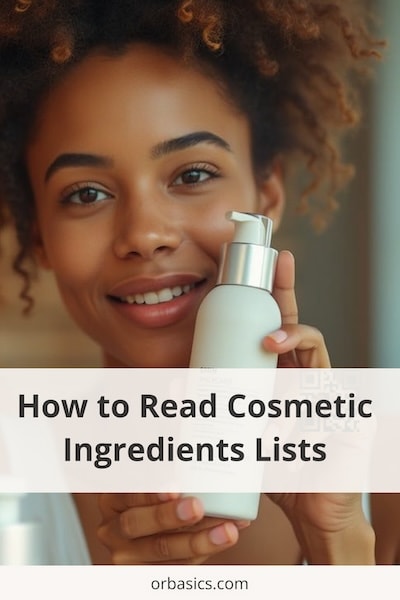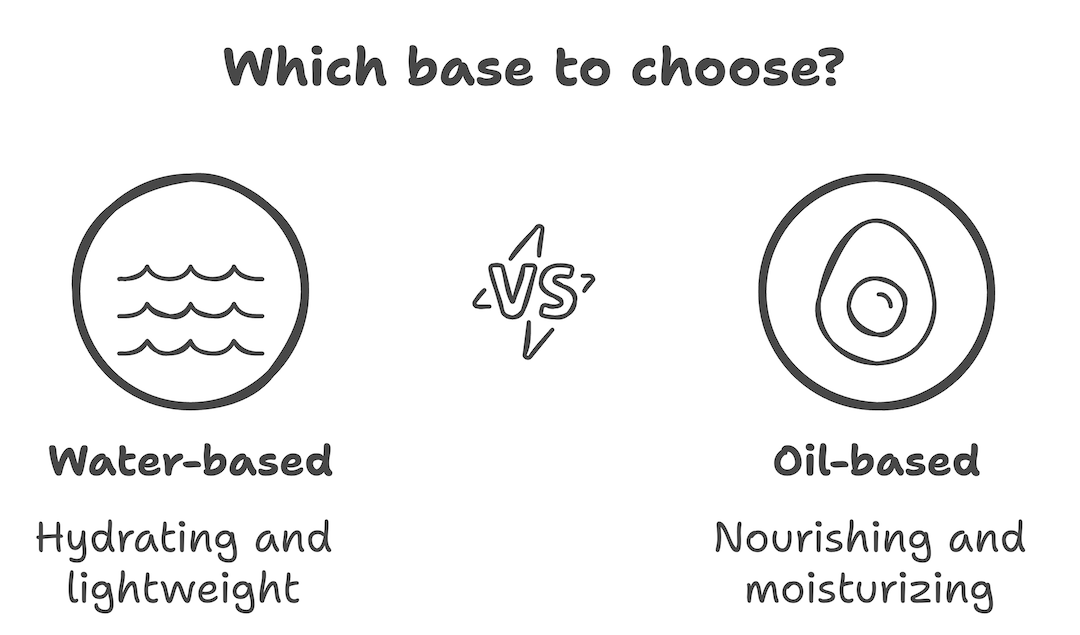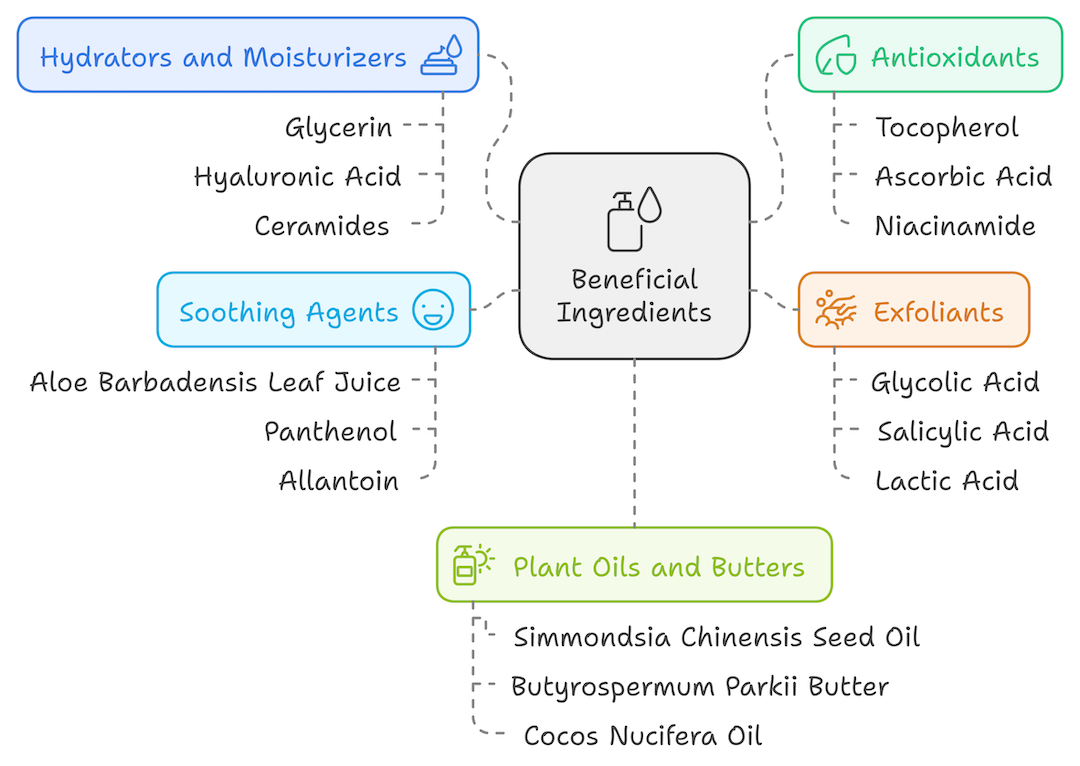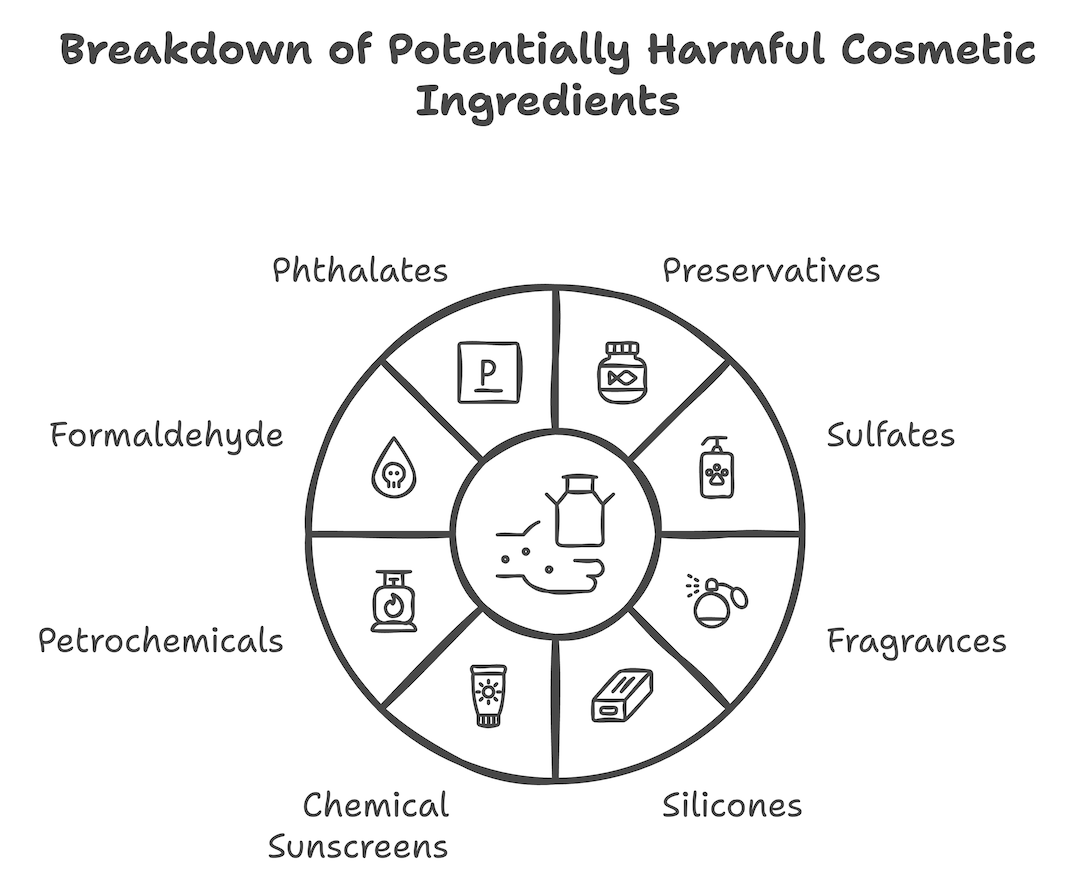Table of Contents
INCI List Decoded: How to Read Cosmetic Ingredients Lists like a Pro
This page may contain affiliate links. We may earn a commission on purchases, at no additional cost to you. Learn more →
Have you ever picked up a beauty product and felt overwhelmed by the long list of unfamiliar ingredients on the label? You're not alone. The world of cosmetics can feel overwhelming.
In today's world of information overload, deciphering what's in our cosmetics can feel like taking a crash course in chemistry.
But there's a key to unlocking this mystery: the INCI list.
INCI, which stands for International Nomenclature of Cosmetic Ingredients, is a standardized system for naming cosmetic ingredients. It's essentially a universal language for cosmetic formulations, designed to bring clarity to consumers worldwide.
Whether you're examining a moisturizer in New York, a sunscreen in Paris, or a face mask in Tokyo, the INCI list ensures that ingredients are named consistently across all products and borders.
But why does this matter to you? The INCI list is your roadmap to making informed choices about the products you use daily. It's the difference between blindly trusting marketing claims and truly knowing what you're applying to your skin.
Through this article, you will learn how to face cosmetic ingredient lists head-on and navigate those tricky components like a pro, identify ingredients that benefit your skin, and recognize those you might want to avoid. So, are you ready to become fluent in the language of cosmetic ingredients?

What is the INCI Listing?
The INCI List is a roadmap to understanding what is in your cosmetic products. With over 25000 ingredients listed for use in personal and cosmetic care, it can be difficult to decipher what is what. The International Nomenclature of Cosmetic Ingredients is an internationally recognized system used in the EU, USA, China, Japan, and many other countries. It provides standardized names for manufacturers and companies to list on their cosmetic product labels. Maintaining a clear understanding of INCI names helps you know exactly what ingredients are in the products you use.
For example, water is always listed as "Aqua," olive oil as "Olea Europaea Oil," and vitamin E as "Tocopherol." This standardization helps consumers identify ingredients across different products and brands, regardless of their location or the product's origin.
So its main purpose is to help you understand what you are putting on your skin, offering clarity and transparency. However, there are drawbacks. Just because an ingredient is on the list doesn’t mean it is approved or safe.
The Origins of the INCI System
The American trade association, the Personal Care Products Council established the International Nomenclature of Cosmetic Ingredients list in 1973. As the cosmetic industry exploded with new products, confusion around the cosmetic ingredients used also erupted. Before the creation of the INCI list, brands used different names for the same ingredients, making it hard to identify what you were using and confusing to compare products.
The original handbook, the Common Ingredient Dictionary, published by the Cosmetic Toiletry and Fragrance Association, sought to soothe the chaos. It soon gained international recognition and remains a standard for cosmetic labeling in many countries throughout the world.
Why do Cosmetic Products Need it?
Transparency. That’s the biggest reason. When you pick up a face serum, you want to know what’s inside, especially if you are passionate about clean beauty, want to uphold values or avoid allergens.
The International Nomenclature of Cosmetic Ingredients list is the first step in figuring out what is in your much-loved products. By listing all the ingredients in a product, it expands your world of understanding. But, to make a healthy choice, you shouldn’t stop there.
Research, Research, Research
Long chemical-sounding names, Latin names, it can all be a bit bewildering. For example, an ingredient like hyaluronic acid might sound harsh, but it's actually a naturally occurring substance in your skin that helps retain moisture. It is often used in clean beauty products. The INCI list is overflowing with aligned names for ingredients, but it doesn’t necessarily explain what they are or disclose their origin.
By listing every ingredient, the INCI List provides an element of consumer safety. It helps you avoid allergens, irritants, or ingredients that don’t align with your values, like parabens, preservatives, or artificial fragrances. However, it is vital to research each ingredient. Check out what new laws are in place, and look for clean beauty certificates, such as Leaping Bunny or EWG. These certifications can provide assurance that the product has been manufactured adhering to specific regulations and can give you a better idea of what you are buying.
Limitations of INCI Lists
While INCI lists are incredibly useful, it's important to understand their limitations:
-
They don't indicate the quality or source of ingredients.
-
They don't specify whether an ingredient is natural or synthetic.
-
They don't provide information about the manufacturing process.
-
Some ingredients, like fragrances, can be listed generically without detailing specific components.
Understanding these limitations is crucial for making fully informed decisions about your cosmetic products.
Exploring a Cosmetic Ingredients List
There is a huge difference between reading what’s in your tin of baked beans and what is in the hand cream you were gifted for Christmas. It can be hard to know where to start. How do you decipher long, complicated ‘chemical names’ or ingredient lists that look like they belong in the last century? If you are unsure where to begin, simply start at the beginning.
Step 1: Understand the Order
The first and most crucial thing to remember is that ingredients are listed in descending order of concentration. The first few ingredients make up the bulk of the product. This applies to both FDA-regulated products and European Union products. This means:
-
The first 5-6 ingredients typically make up 80-90% of the product
-
Ingredients listed after the first 5-6 are usually present in small amounts (less than 1%).
-
Ingredients at 1% or less concentration can be listed in any order.
-
Color additives can be listed at the end, regardless of concentration.
Step 2: Identify the Base
Most cosmetic products are water-based or oil-based. Look for these common bases:
-
Water-based: "Aqua" (water) is usually the first ingredient.
-
Oil-based: Look for oils like "Helianthus Annuus Seed Oil" (Sunflower Oil) or "Cocos Nucifera Oil" (Coconut Oil) near the top of the list.

Step 3: Recognize Common Ingredients
Familiarize yourself with common ingredients and their functions. For example:
-
Glycerin: A humectant that attracts moisture to the skin.
-
Cetearyl Alcohol: An emollient and thickener (despite the "alcohol" in its name, it's not drying).
-
Tocopherol: Vitamin E, an antioxidant.
Step 4: Look for Active Ingredients
Active ingredients are the star performers in a product. They're often listed by their scientific names. Some examples:
-
Niacinamide: Vitamin B3, good for brightening and reducing pores.
-
Salicylic Acid: A beta-hydroxy acid (BHA) used for acne treatment.
Step 5: Check for Potential Irritants or Allergens
Be aware of ingredients that might not agree with your skin:
-
Fragrances: Listed as "Parfum" or "Fragrance"
-
Common preservatives: Parabens, phenoxyethanol
-
Sulfates: Sodium Lauryl Sulfate (SLS) or Sodium Laureth Sulfate (SLES)
- Microplastics as PFAs
Pro Tip: If you have sensitive skin or known allergies, always patch-test new products.
Step 6: Identify Natural vs. Synthetic Ingredients
While not always straightforward, you can often spot natural ingredients by their Latin names:
-
Lavandula Angustifolia: Lavender
-
Butyrospermum Parkii: Shea Butter
-
Simmondsia Chinensis: Jojoba
Synthetic ingredients often have chemical-sounding names, but remember, not all synthetic ingredients are harmful, and not all natural ingredients are beneficial for everyone. For example, "Sodium Hyaluronate" is just the INCI name for hyaluronic acid, a beneficial skincare ingredient.
Step 7: Use Technology to Your Advantage
There are numerous ingredients decoder apps and websites that can help you decode INCI lists. Some popular ones include:
-
EWG's Skin Deep Database
-
Think Dirty App
-
CosDNA
These tools can provide quick information about ingredients and their potential effects.
What are The Main Ingredients in Cosmetics?
With an abundance of personal care products on the market, it would be hard to know and memorize every single ingredient. Here is a breakdown of some key ingredients to love, to be wary of, and to avoid.
Beneficial Ingredients
-
Hydrators and Moisturizers
-
Glycerin (Glycerol): A powerful humectant that attracts moisture to the skin.
-
Hyaluronic Acid (Sodium Hyaluronate): Holds up to 1000 times its weight in water, providing intense hydration.
-
Ceramides: Lipids that help maintain the skin barrier and lock in moisture.
-
-
Antioxidants
-
Tocopherol: Vitamin E, protects against free radical damage.
-
Ascorbic Acid: Vitamin C, brightens skin and boosts collagen production.
-
Niacinamide: Vitamin B3, improves skin texture and reduces pore size.
-
-
Exfoliants
-
Glycolic Acid: An alpha-hydroxy acid (AHA) that promotes cell turnover.
-
Salicylic Acid: A beta-hydroxy acid (BHA) that unclogs pores, great for acne-prone skin.
-
Lactic Acid: A gentle AHA suitable for sensitive skin.
-
-
Soothing Agents
-
Aloe Barbadensis Leaf Juice: Calms irritated skin and provides hydration.
-
Panthenol: Pro-vitamin B5, helps soothe and heal the skin.
-
Allantoin: Calms and protects sensitive skin.
-
-
Plant Oils and Butters
-
Simmondsia Chinensis Seed Oil: Jojoba oil, similar to skin's natural sebum.
-
Butyrospermum Parkii Butter: Shea butter, rich in fatty acids and vitamins.
-
Cocos Nucifera Oil: Coconut oil, has antimicrobial properties (but can be comedogenic for some).
-

Red Flags: Potentially Harmful Ingredients
Be cautious (or simply avoid) harmful ingredients such as parabens, sulfates, or silicones. Used as preservatives, evidence is emerging that parabens such as methylparaben have the potential to be carcinogenic. Silicones, used in cosmetic products, may become toxic; cyclosiloxanes are known as Bio-accumulative. Through growing your awareness of ingredients, you can make better choices and avoid toxic make-up and skincare products.
-
Preservatives
-
Parabens (e.g., Methylparaben, Propylparaben): Linked to hormone disruption in some studies.
-
Phenoxyethanol: Can irritate in high concentrations.
-
Formaldehyde-releasers (e.g., DMDM Hydantoin): Can be irritating and are potential carcinogens.
-
-
Sulfates
-
Sodium Lauryl Sulfate (SLS): A harsh cleanser that can strip the skin of natural oils.
-
Sodium Laureth Sulfate (SLES): Milder than SLS but still potentially irritating for some.
-
-
Fragrances
-
Parfum/Fragrance: Can cause allergic reactions or irritation in sensitive individuals.
-
Essential Oils: While natural, they can be irritating for some people.
-
-
Silicones
-
Dimethicone: Creates a smooth feel but can trap bacteria and oil for some skin types.
-
Cyclopentasiloxane: Provides a silky texture but may accumulate in the environment.
-
-
Chemical Sunscreens
-
Oxybenzone: Potentially hormone-disrupting and harmful to coral reefs.
-
Avobenzone: This can be unstable and irritating for some people.
-
-
Petrochemicals
-
Mineral Oil (Paraffinum Liquidum): Derived from petroleum, can clog pores for some.
-
Petrolatum: Similar to mineral oil, can be occlusive.
-
-
Formaldehyde and Formaldehyde-releasing Preservatives
Examples: DMDM Hydantoin, Imidazolidinyl Urea, Diazolidinyl Urea
-
Formaldehyde is a known carcinogen, that can cause skin irritation and allergic reactions
-
Potentially toxic when inhaled (more relevant for hair straightening treatments)
-
-
Phthalates
Examples: Dibutyl Phthalate (DBP), Diethyl Phthalate (DEP)
-
Potential endocrine disruptors
-
May increase the risk of hormone-related cancers
-
-
Alcohols (when high on the ingredient list)
-
Alcohol Denat. (Denatured Alcohol): Can be drying and irritating in high concentrations.
-
Isopropyl Alcohol: Can disrupt the skin barrier if used excessively.
-

Follow your natural gut feeling. If there are questions surrounding an ingredient, opt for a natural alternative. Synthetic fragrances can result in allergies or skin irritation, so choose a product that has a natural fragrance, derived from essential oils. Certain ingredients present, like Titanium Dioxide can be harmful if inhaled. Although it is a common mineral-based UV filter, avoid using it in loose powders.
Simplifying the INCI List: A Beginner's Guide
Decoding INCI lists can seem overwhelming at first. Life is busy and your mind is overflowing with things to do, choices to make, and on top of all that, figure out what’s for dinner. But, you have that nagging feeling that just understanding a few ingredients might mean better choices for you and your family.
Take it slowly, start simple, and then dive deeper. Don’t let complicated names put you off. The INCI lists often have ingredient names that resemble the elements common name. Once you have grasped a few basics you will be on the way.
Let’s explore some basics and understand when you might need to probe a bit more.
Start Simple: Identify the Basics
Aqua
Water is vital for survival and is pretty high up on the INCI ingredient list. Often the first ingredient, Aqua or water, is used in many products, from serums to cleansers. Water not only hydrates but acts as a solvent for other elements like humectants and emulsifiers.
You might not think you can go wrong with water, but a drawback of the INCI list is the inability to know the quality of the water. Is it purified or distilled?
Plant-based Ingredients
Botanicals or plants are a great place to start. Botanical ingredients can be plant extracts, leaves, roots, seeds herbs, or flowers. These botanical ingredients follow specific INCI guidelines using their Latin botanical names. The vivid orange marigold is Calendula Officinalis while the gentle rose is recognised by Rosa Damascena. At first, these names can appear foreign, but through time, you will begin to distinguish them. If you gravitate towards plant-based products, picking a few to learn each week can be helpful.
Caution: It is good to remember that while the ingredient may be listed as a plant name, the INCI list won't tell you if it is in a natural state or chemically altered. For example, coconut oil, listed as Cocos Nucifera, could be raw coconut oil or a synthetic derivative made from coconut oil.
Parfum
Fragrance or perfume can be tricky to decipher as it can come from natural sources like essential oils or from synthetic chemicals designed to mimic natural scents. The term "parfum" doesn't specify which. This lack of transparency can be problematic, especially if you're sensitive to synthetic fragrances or trying to avoid them. An exception is found in organic cosmetic products. Within this range, parfum must be natural or derived from essential oils.
Tips for Navigating INCI Lists
-
Take it slow: Learn a few ingredients at a time
-
Focus on the first 5-6 ingredients: These make up the bulk of the product
-
Look for familiar terms: Many INCI names resemble common names
-
Use resources: Ingredient databases and apps can help decode complex names
-
Be aware of dual nature: Some ingredients (like Cocos Nucifera/Coconut Oil) can be natural or synthetic derivatives
-
Check the product purpose: Different products will have different key ingredients
-
Be mindful of concentrations: Ingredients are listed in descending order of concentration
-
Research unfamiliar ingredients: When in doubt, look up unknown ingredients
-
Consider your skin type: What works for others may not work for you
Remember, understanding INCI lists is a journey. As you become more familiar with common ingredients, you'll find it easier to make informed decisions about your skincare and cosmetic products.

Knowledge is Power
Understanding the INCI list and its limitations can give you control over your choices. It helps you avoid ingredients that may not be beneficial to your health and embrace those that will. You don’t have to have a chemistry degree to read the ingredient lists on your favorite toiletry or the conditioning mask your split ends crave. You need to know what to look out for.
So, the next time you are standing in the cosmetic aisle, choosing a new product, make that choice with confidence. You are armed with the ability to decipher INCI lists, how to simplify the chaos of words, and make better choices for your skincare and health.
If you enjoyed this post, check out these other articles on safe and non toxic products:
The Best Non-Toxic & Natural Skin Care Brands for a Vibrant Glow
My Non-Toxic Skincare Routine: Clean Beauty Tips for Healthy Glowing Skin
Embrace Non Toxic Living: Your Guide Towards a Healthier, Chemical-Free Lifestyle













